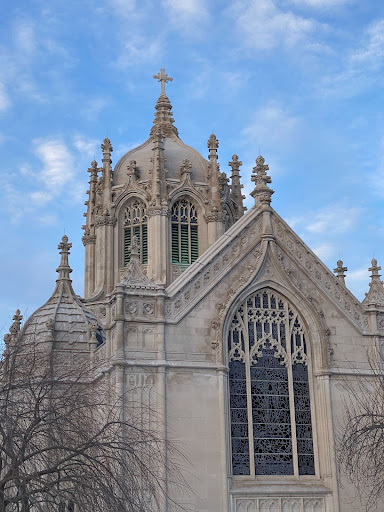A Stroll Through Green-Wood Cemetery in Brooklyn, A National Historical Landmark
A journey through time at one of the most historic cemeteries in New York City.
My favorite time of year to visit the Green-Wood Cemetery in Western Brooklyn is mid-winter, particularly after a snowstorm. The pond freezes over with temptingly ice-skate-able ice and the mausoleum doors chill into place, tightly sealed by a thick, fluffy layer of snow. Each of Green-Wood’s 600,000 permanent residents seems to breathe a collective sigh of relief at the lack of birdwatching troops and picnicking families, enjoying the silent, peaceful cool of the snow-covered cemetery. In this relief they are justified — the cemetery has historically attracted hundreds of thousands of visitors per year, previously drawn in by the prestige of the cemetery’s residents and the carriage rides through the sweeping greens, and currently by the memorialization and admiration of the historic cemetery and its vast and historic grounds.
Founded in 1838, Green-Wood cemetery gained a reputation within its first twenty years unlike any other cemetery in the country, let alone in New York City. With the construction of Central Park and Prospect Park only just beginning, New Yorkers and tourists flocked to the cemetery just as they now do to New York City’s famous parks, seeking refuge from the urban lifestyle through the cemetery’s natural beauty. The number of visitors in 1860 was so high, that it earned the second place title as America’s greatest tourist attraction, just behind Niagara Falls.
Green-Wood Cemetery’s 478 acres of ponds, paths, hills, and valleys also hold a particular significance to American history as the site of the Battle of Brooklyn Heights in 1776, an American defeat and the largest battle of the American Revolution. War continued to ravage the surrounding landscape even after the cemetery’s opening, given the Civil War in 1861. A “soldier’s lot” was created, providing free burials to those killed in the war. Many of the dead were unidentified, and thousands were buried without proper markings. The cemetery worked to remedy this problem in 2002 by starting a Civil War project, locating the graves of those who fought in the Civil War and installing memorial markers. A similar project was launched in 2021 called the Green-Wood World War II Project, this time honoring those who served and are interred at Green-Wood through the creation of a series of biographies.
Alongside the many nameless residents, lie those whose demarcations almost seem to repel any sense of anonymity. Those who walk past cannot help but glance, perhaps even stare, at the distinct grandeur of the dead’s home. Their headstones, mausoleums, sculptures, and monuments are made up of stained glass windows, angels carved from stone, gilded doors, and roofs held up by columns. Their family names are engraved so broadly, so elegantly, that their family names stick in your head until you reach the cemetery gates and leave the oasis behind. But, of course, you may already know these names: Jean-Michel Basquiat, Horace Greely, Leonard Bernstein, DeWitt Clinton, and Boss Tweed, amongst many others. Neo-Expressionist painters, newspaper editors, orchestra conductors, governors, and corrupt politicians; all are memorialized by literature, by Google searches, and by their Green-Wood monuments.
Allie Smithie ’22 and I visited Green-Wood Cemetery last winter, and we took pleasure in seeking out the decadence of the less conspicuous dead. “I love looking for the Tiffany stained glass windows and seeing a family’s history, through the ways in which they chose to represent themselves after death. Green-Wood cemetery has so many distinctive charms in different seasons,” said Smithie.
Ornithologists and bird watchers also take pleasure in spotting Green-Woods live residents, a flock of gregarious monk parakeets as well as bald eagles. After the parakeets posed a threat to the Argentine government’s plan to expand their agricultural output in the 1950s, the government shipped them to the United States. Eventually, many of these parakeets found their way to Green-Wood’s gateway, building nests in the spires of the gothic 25th Street entrance. The location is ideal for the parrots – Green-Wood stands at Brooklyn’s highest natural point, easily accessible for migrating birds traveling along the Atlantic Flyway.
Perhaps just as intriguing as the cemetery’s permanent residents, both living birds and dead citizens, are its extensive archives and historic fund collections, which are accessible online. Thousands of artifacts and artworks have been collected and cataloged, in order to advance public knowledge and to foster an appreciation of the cemetery. These have been divided into an art collection, a historical collection, and a library collection. Green-Wood’s other resources include Greenealogy (a genealogy service) and the landscape and living collection (documentation of Green-Wood’s flora and fauna).
An exclusively in-person resource that I find to be particularly fascinating is the installation artist Sophie Calle’s installation, Here Lie the Secrets of the Visitors of Green-Wood Cemetery. Calle’s project began in 2017, and invited visitors to slip their secrets into a marble obelisk which was periodically emptied and burned. The twenty-five-year-long installation brings an interactive quality to the cemetery, allowing visitors to – in a way – bury their own metaphorical dead.
Although I haven’t yet slipped any secrets into the obelisk, I plan to seek it out on my next visit, armed only with undisclosed secrets. I will pass by the parakeets and the pond, the mausoleums and the monuments, and the trees and Boss Tweed, instead choosing to connect with the past and present in a way that can only really be experienced in person at Green-Wood cemetery.
“I love looking for the Tiffany stained glass windows and seeing a family’s history, through the ways in which they chose to represent themselves after death. Green-Wood cemetery has so many distinctive charms in different seasons,” said Allie Smithie ’22.
Ellora Klein is a Copy Chief for ‘The Science Survey.' She enjoys exploring different perspectives through writing, editing, and reading. Ellora chose...











